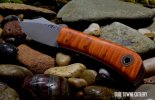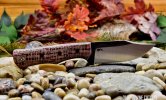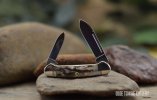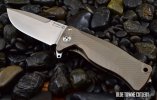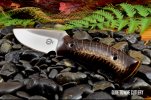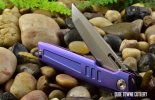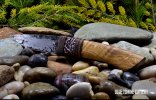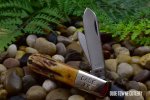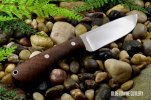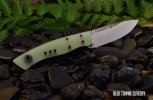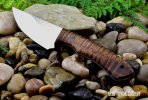I can add a little insight to these comments from Olde Towne Cutlery. Melissa and I were not expert photographers when we started this business, but we could take a picture. We had no idea how hard that was going to be. Ten billion images later, we started to get the hang of it. The challenges are too long to list in this post, but the main ones (stills a long list) are as follows:
Knives are very reflective. You have to massage the light conditions greatly in order to get a photo with high resolution that shows color accurately without being washed out or too dark. This is actually hard as hell.
Getting a long skinny object in a two dimensional plane is really hard to represent. A persons face is easy to fill a frame, but a knife often has to be turned diagonal or shot lengthwise in order to see enough detail. We have three different lenses on a very high quality Nikon and it is a serious challenge to show enough detail in the Burl of a handle if the knife is straight on. And if it seems like the answer is “just take it from farther away”, let me assure you that this doesn’t work. If you shoot a Fiddleback camp knife or a TM Hunt M18 and it only takes up 30% of the frame in a horizontal image, leaving 80% dead space above and below the knife, the consumer will think those are the size of a Case Toothpick. Seriously. Proportion is everything. And that starts with then knife in as much of the frame as possible; especially on a big knife.
The straight on shots are definitely important, and we always shoot a couple when doing each knife. But often the straight on does not come out right and looks terrible. Depth of field (F-stop) is often the impediment. The image doesn’t like a “half flat, half reflective” surface and it will often throw the whole depth of field in the wrong place and or just make a bad image. That’s why you will often see good pictures with the knife at a slight angle running toward or away from the lense. Because the f-stop and shutter work together to make somewhere on that knife in really sharp focus. If the knife were flat to the lense, about 75% of the time it doesn’t come out. But I assure you that we try for this image! Whether you manually focus or use the auto function makes no difference. The spot in sharpest focus is never exactly where you think it is. And if it’s a flat image, there is no margin of error for the camera. Yet if the knife is coming toward or away from the lense, it’s ok because it will have something you want in the sharpest focus. This way, the customer gets to see the highest resolution of at least something, rather than a slightly blurry image of a whole knife.
As for color, I think we get this one right but I know a lot of people struggle. My advice is, outdoor photos in natural light on a cloudy day is ALWAYS best. But if you need to shoot indoors, (and we usually do), then LED daylight hue bulbs in a can light filtered through plain white fabric works best.( Just trust me here - lots of experimentation). Lighting is hard, but we think it’s really important to get a good photograph with accurate colors. More on white balance below.
Regarding background, this might be a revalation for some. But shooting a knife on a plain background is even harder. The reason is because the knife surfaces are usually smooth a polished. Cameras hate this. See, human skin or nature has “texture” and the lense can detect the surface of the image. A polished surface is MUCH harder for the lense to see. So you need a background with texture. We use pea gravel a lot and we use straw, ferns, leaves etc. This texture gives the lense something to “register” the smooth shiny image against. Trust me, if you try to photograph a super curly koa handle knife with a polished blade on a smooth background, it will not work. Not unless you’re a magician. But take that same curly koa and put it on some pea gravel and voila!
Backgrounds also give the camera what they call “white balance”. The camera needs to see other colors in the spectrum so that it can get the colors correct. We find that pea gravel, leaves, old boards and things like that enable the white balance monitor to get the color of the handle right and therefore we do not ever do any color modification. We want a true-to-life color representation every time out of the gate.
Finally, we try to get every angle and every feature of a knife. Left, right, tapered tang, underside of the handle, makers mark, grind features and pinout or other feature. So with a single knife, this is about 12 raw images. Now imagine you just bought 20 knives and need to get them up for sale. That’s 240 pictures. And you can’t load a raw image on a website. Plus, EVERY FRIGGIN PICTURE HAS A TERRIBLE BLOB OF LINT THAT YOU DIDNT BLOW OFF BEFORE SHOOTING THE GOD DAMN PICTURE. So you gotta fix that with your photo editing software, and then shrink the image. One photo shoot and editing session on 20 Knives is about three hours of work. Granted, for knife geeks like me; it’s not exactly like cleaning septic tanks. There could be worse jobs than playing with knives!!! (By the way, I did cut the shit out of myself on a Southern Longbeards I was shooting tonight. So there are job hazards!!! Damn his knives are sharp!)
Anyway, the learning curve on taking good knife pictures is STEEP. But we do try really hard to get a good image for you.
As a final thought, we are knife geeks too. If you aren’t happy with the knife then we aren’t happy. PLEASE return it for a full refund. I am a collector for over 30 years and I struggle too to buy on-line sometimes. Pictures can only tell you so much. (This is the real reason we opened Olde Towne Cutlery. But it is a bit like Al Pacino in Scarface. I get high on my own supply a little too often and sometimes when I’m in my office with hundreds of my personal knives, I feel like that scene at the end of the movie where he has that giant pile of cocaine on his desk.) Anyway, whoever you buy from, do business with people who are knife enthusiasts like you. They care about your happiness and satisfaction. We do. That means something and it’s not just a business and a widget running through a cash register.
In conclusion, you have our commitment to take the best and most accurate pictures possible. But if it’s not what you expected, we don’t ever want you to hesitate to return it. When we started this business, Melissa and I said we would create a place where we would want to shop. And as a fellow knife geek, you have our commitment at Olde Towne Cutlery.
Here are a few photos we like. Enjoy and thanks for reading my ramble! Lee
